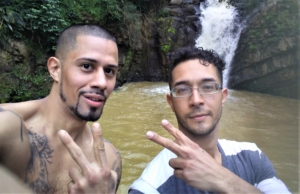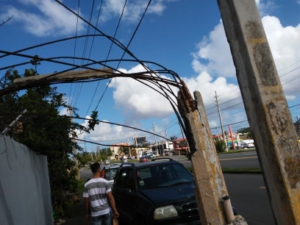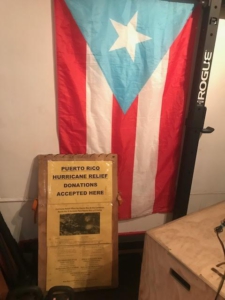
It is six months since category 4 hurricane Maria hit Puerto Rico on Sept. 20, 2017. The worst storm since 1928, it caused massive destruction, hundreds of deaths, closed down hospitals and schools as well as the entire electrical grid, which is still not completely fixed. It altered the lives of over 8 million Puerto Ricans living in the homeland and in the United States
Puerto Rican nationalist Richard Lopez and I recently went to Puerto Rico to visit family, and to observe the long-lasting effects the storm has had on the island. We had many interactions with people across the island. They shared similar stories of horror and US government neglect during and following the storm.
Different routes to the motherland
Richard and I took different routes to our motherland. I am Nuyorican, born in New York, who eventually moved to New Jersey. Spanish is my second language and I do not speak it fluently. My first remembered experience in Puerto Rico is as a 14-year-old–visiting some family for a week and doing some touring. I didn’t connect with the island until my early 20s, when I was financially capable of traveling back and forth alone.
Richard was born in New York City but went back to the island at a young age to grow up there, become politicized there, and eventually leave due to our deviant government which intimidates and criminalizes those who seek an independent and sovereign Puerto Rico.
Deeply angered at US government negligence
We were both deeply angered that the U.S. government, responsible because it is the colonizer of Puerto Rico, was slow to act in the aftermath of Maria, stalling basic necessities in port, and leisurely taking its time in granting aid to its own “citizens” [Puerto Ricans are U.S. citizens, though they cannot vote in national elections]. We were frustrated that our country was denied aid from countries such as Cuba and Venezuela, who were immediately ready to respond, but prevented from doing so by a web of U.S. legislation designed to keep Puerto Rico poor, exploited and isolated.
We both noted that the true heroes in the aftermath of hurricane Maria were the Puerto Rican people. There were the numerous volunteers who came to Puerto Rico to work on the electrical grid. There were brigades that reached the people in isolated mountain areas, covering their damaged roofs with tarps, bringing the people medical supplies and food. There were the millions of Puerto Ricans abroad who donated power generators and cash, and who loaded and paid to send to the island shipping containers filled with baby clothes, batteries and water, food– anything needed for our people.
Many areas are in complete darkness

Our plane landed in San Juan’s airport in middle of the night, and I saw that the city had lights. I had expected worse. In the morning, however, we were really able to see the damage that still exists 6 months after the storm. San Juan and the surrounding metro area may have lights, but this a small geographical fraction of Puerto Rico. Traffic lights, even in the San Juan area, were still not functioning.
As we ventured across the island and into the mountains we saw many areas in complete darkness. We went to several municipalities across the island and witnessed unabashed destruction. Trees and power lines were still down, utility poles were broken in half; many homes still had their roofs torn off, their facades decaying.
Little attention has been paid to addressing the losses faced by millions of people. But corporate giants such as Walmart and McDonalds were easily accessing funds to repair their stores and remain profitable.
We visited family. My family is in Toa Baja, a suburb of Bayamon. They told us they did not have electrical power for five months. For the past three weeks they have had electricity. Their home has been running on a diesel-run generator, a luxury that many Puerto Ricans cannot afford. Portions of their house were destroyed, and the majority of the trees on their property were uprooted.
A family member of Richard’s was not as lucky. Her home in Arroyo, where the hurricane hit, was completely destroyed. She said that FEMA, the Federal Emergency Management Agency, will only give her enough money to cover a small portion of the damage. She stayed on the island, renting a room to have a roof over her head. But many have not. We found that abandonment of homes that are no longer habitable is widespread. Richard who grew up on the island, was hurt by the extent of the depopulation.
Extensive environmental damage
The environment of this beautiful land has been depleted, Richard observed. He noted “the contamination of bodies of water, how people said ‘everything looked burnt,’ making you think what environmental experiments were they exposed to?” He continued, “We hardly heard coquís [Puerto Rico’s tree frogs] and the island looked desolated from what I remembered. In people’s eyes, you could read the trauma and exhaustion.”
We hiked to a waterfall in Naranjito, near the north coast, that Richard grew up enjoying. The path to the waterfall was a difficult climb through trees and fallen debris. “It seemed as though nobody has come up here since Maria,” Richard said. He was disgusted of the filth of the water. It used to be “clean and blue,” he said, but was now a tint of brown. We were even warned by the people of the town not to go into the water.
Rat infestations, pig overpopulation
In several areas, including the cities of Bayamon and Jayuya, we were told of rat infestations since Maria. Some said, “Rats were eating everything.” Others pointed out that water contaminated with dead rats and with rat urine has led to cases of Leptospirosis, a infectious bacterial disease.
We were also told that many farms were abandoned, and that livestock is roaming free. An overpopulation of pigs is becoming problematic.
Many Puerto Ricans are waiting for the harvest since Maria devastated the last one. I noted that fruit stands did not have the selection of fruits I am accustomed to in seeing in Puerto Rico. Available were some bananas and a couple root vegetable which grow in the ground.
Rebuilding jobs not given to Puerto Ricans
We drove a lot while we were in Puerto Rico. The main expressway from San Juan to Ponce was filled with potholes. Exit signs, which fell during Maria, were still on the ground, the debris closing lanes.
There were long traffic jams in the mountains. I got out of the car to investigate. It turned out that workers were cutting dead limbs off the trees to make the road safer for motorists. Turns out the people doing the cutting were from Alabama. Alabama? Why is this work not being done by Puerto Ricans who are suffering massive unemployment? The Alabama contractors were being paid high salaries, not to mention that tax money was paying for their transportation, housing and

food. Only under capitalism would the Puerto Rican workers be neglected as their work was being outsourced to a company that was probably a contributer to Trump’s electoral campaign!
Puerto Rico has a higher poverty rate than any state in the continental United States. Poverty increased from 44 percent to 52 percent after Maria. The official unemployment rate hovered around 11 percent before Maria. It is certainly much higher now, as many businesses are still closed.
The lack of jobs and services and the destroyed housing has hundreds of thousands of Puerto Ricans fleeing the island. This has depleted a much needed tax base. The Jones Act, an illegal tariff in place for over a century, jacks up the prices of everything in Puerto Rico, making simple survival an even greater struggle. Add in the swelling debt of $ 72 billion demanded by US banks and you have a formula created in Washington for Puerto Rico’s self-implosion.
Puerto Ricans remain proud and resilient
But those who are still in Puerto Rico have remained resilient and spirited, taking pride in their island. Today, the old Puerto Rican flag with the lighter blue colored triangle, associated with the independence struggle, fills the countryside. These flags are standing alone, not beside the American flag of a voracious colonizer, as was often the case before.
“La Estrella no caba en la bandera Americana” [The star (of the Puerto Rican flag) does not fit in the American flag-ed]. The only solution to this crisis is a fully independent and sovereign Puerto Rico, not a Puerto Rico bought off by big business.




